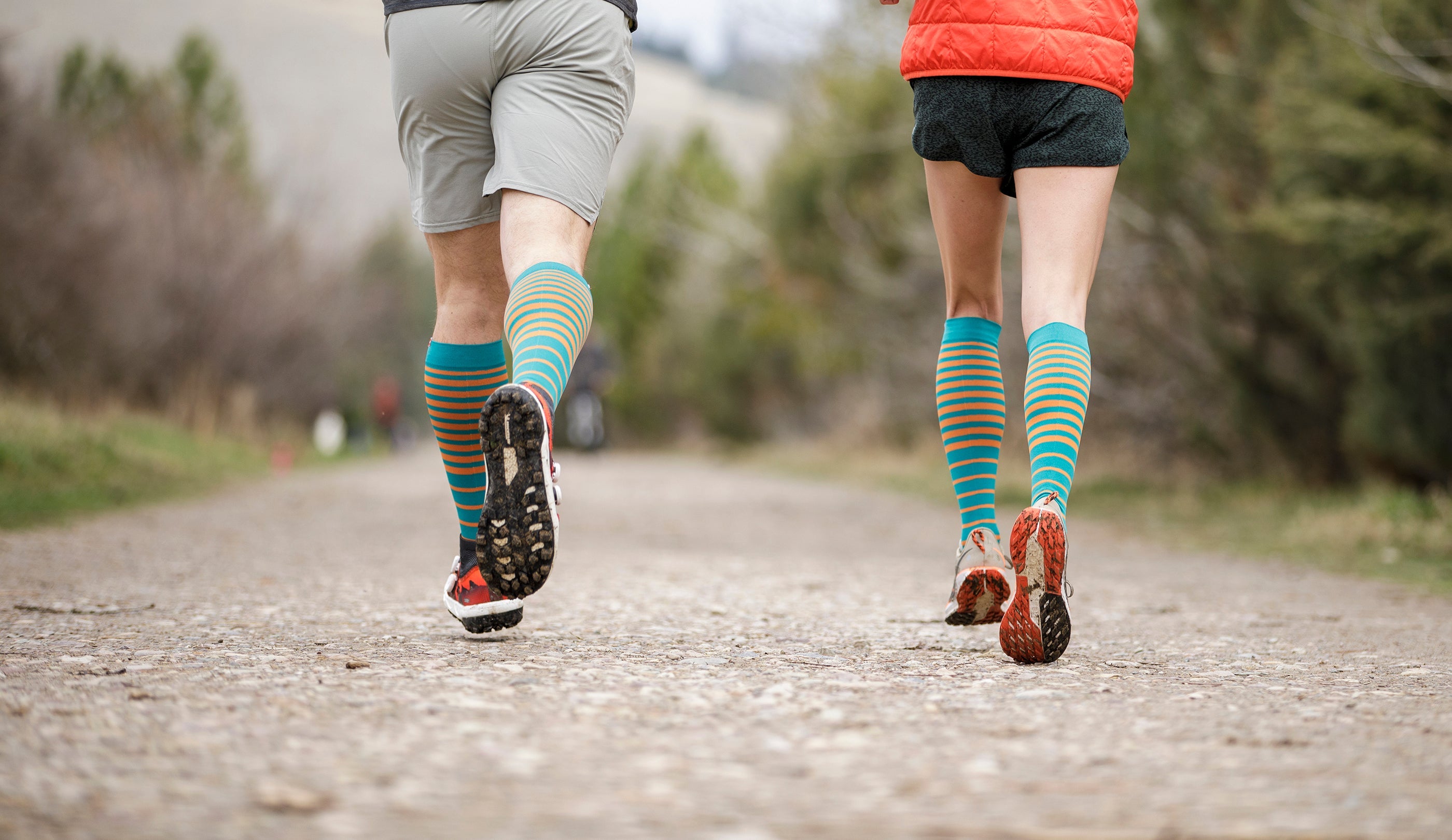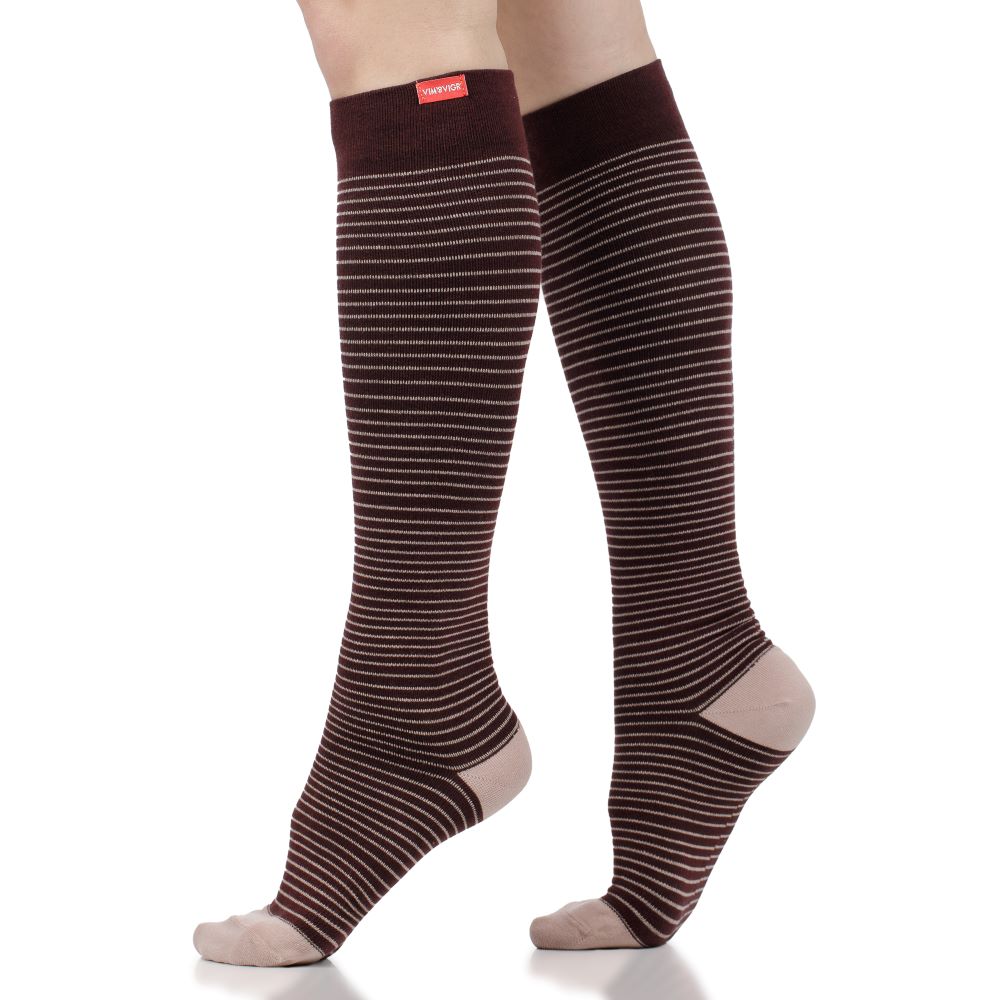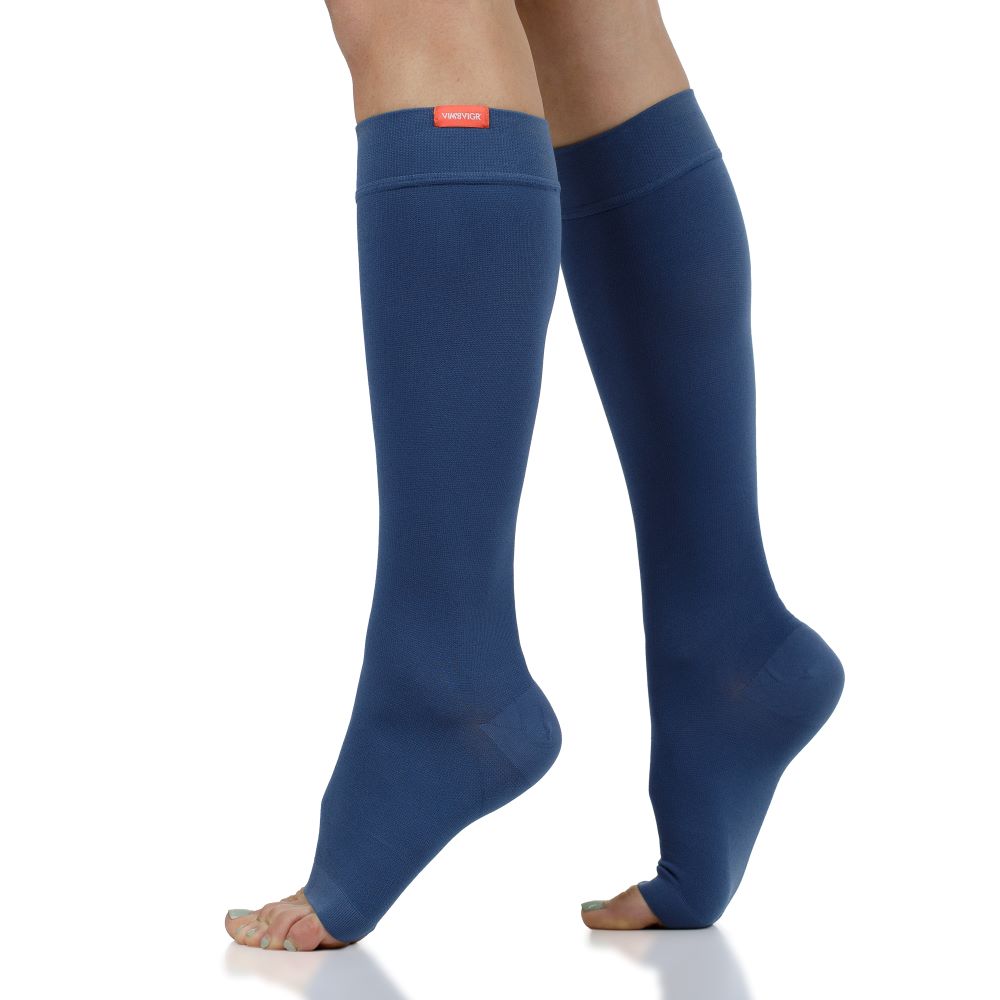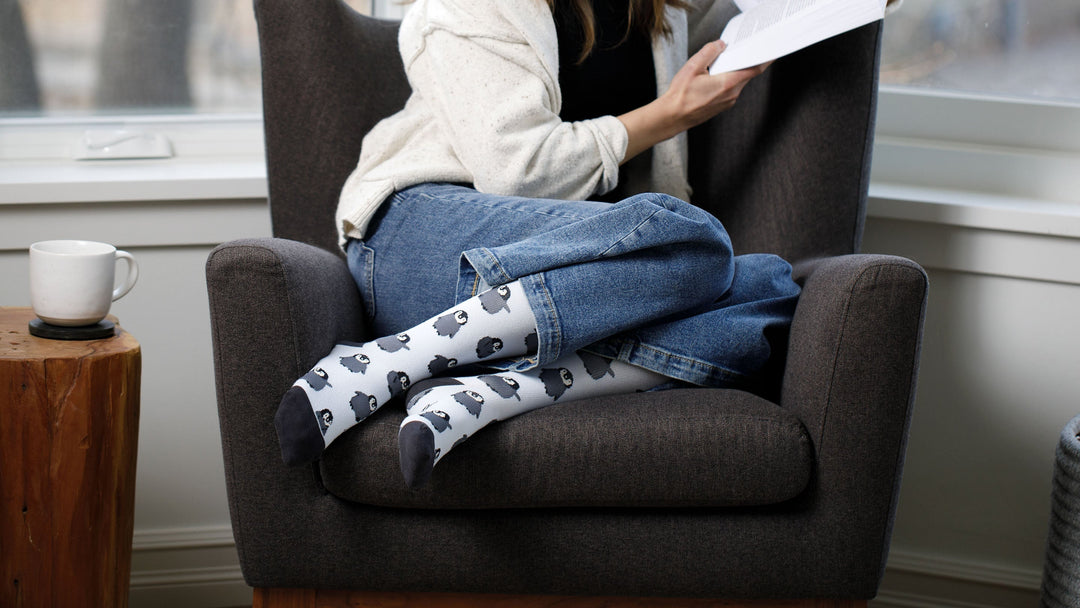How Do Vasovagal Syncope Compression Stockings Work?
A syncope is a sudden loss of consciousness - in other words, fainting. When your body reacts to specific triggers, such as the sight of blood or extreme emotional distress, we talk about vasovagal syncope (also known as neurocardiogenic syncope). And this accounts for at least 35% of cases of sudden fainting.
Although vasovagal syncope is generally a benign condition, there is the risk of injuring yourself during an episode (for example, by failing and hurting yourself). There are no specific treatment needs for it, since it’s not considered life-threatening or even impairing. However, if you can control blood flow and blood pressure to an extent, to allow you to manage and reduce the risk of a vasovagal syncope, you can feel more reassured and comfortable in your daily life.
In this article, we’ll explore how compression socks and stockings can help those who suffer from episodes of vasovagal syncope. Read on to find out the scientific arguments for compression in this case, the benefits, and how to use your vasovagal syncope compression stockings.

What is Vasovagal Syncope and How Can Compression Socks Help?
A vasovagal syncope is an episode where you faint because of your body overreacting to some external stimulus like the sight of blood or extreme emotional distress. These events make your heart rate and blood pressure drop really suddenly. As a result, less blood flows to the brain and you lose consciousness.
Compression socks and stockings are effective and convenient methods to boost blood flow in the lower limbs, ensuring that your cardiovascular system works at its best. Graduated compression socks, in particular, push the blood up from the legs and feet towards the heart. This avoids it pooling at the bottom of your body and creating any shortages of volume of blood in the body overall. It also reduces the risk of a number of circulatory problems and of swelling and pain in the limbs.
By helping to maintain a well-functioning circulatory system, compression socks play a small part in enhancing venous return (the return of blood, through your veins, to the heart) and optimizing the circulation of blood in the body. Moreover, vasovagal syncopes often occur as a result of orthostatic hypotension or of standing for long periods of time. Compression socks are ideal for use in these scenarios, as they help keep blood flowing freely and prevent the risk elements that these scenarios create.
The Science Behind Compression Socks for Vasovagal Syncope
Graduated compression socks and stockings are instrumental in optimizing peripheral circulation. They apply a gentle pressure to the lower extremities, which stimulates blood flow in the area and outwards towards the heart.
Because graduated stockings are tighter at the feet and ankles and slowly decrease pressure as they climb towards the knee, this effectively pushes the blood upwards. It prevents it from pooling around the ankles when you stand or sit for long periods of time. It’s also an effective shield against risks of blood clots during long flights and other types of static travel.
Finally, a systematic review of studies on the role of compression stockings in vasovagal syncope cases confirmed that full-length garments like stockings work better against blood pressure changes caused by postural changes (for example, orthostatic hypotension).

Benefits of Compression Stockings for Vasovagal Syncope
Through the pressure they put on the legs, stimulating blood flow back up towards the heart and preventing it from pooling at the periphery, compression stockings offer multiple benefits to those at risk of vasovagal syncope. They not only improve circulation overall, but also help reduce orthostatic stress and enhance venous return.
Improved Blood Circulation
An overall improvement in blood flow is linked with wearing compression stockings and socks. By stimulating blood flow through the legs and back into the wider cardiovascular system, compression garments help reduce circulatory problems and keep the organism functioning at its best.
Even with the best efforts to live and eat healthily, there are many times in our lives when our circulatory system is put under stress: long flights or travel where we don’t move for long periods of time, pregnancy, desk jobs where we sit for long stretches, jobs that require us to be on our feet (nurses and teachers, among others), or surgery and subsequent recovery. A decrease in movement increases our risk of developing blood clots, venous insufficiency, and other issues that compression stockings fight against. Through this support, they can also help reduce the risk of vasovagal syncopes.
Reduced Orthostatic Stress
Orthostatic stress is common, but can lead to fainting from a vasovagal syncope. It refers to those times when blood is moved away from the chest to below the diaphragm, causing low blood pressure. “Orthostatic” means “relating to, or caused by an upright posture” - so all the times you stand up suddenly. To reduce orthostatic stress and orthostatic hypotension, compression therapy can be considered as a treatment.

It’s important to note that the simple use of compression stockings doesn’t necessarily mean you will no longer suffer from orthostatic stress. However, studies show that compression plays a part in regulating blood flow and thus homogenizing blood pressure in the body. There are also recommendations that compression stockings should be paired with a form of abdominal compression to boost effectiveness.
Enhanced Venous Return
Vasovagal syncope is triggered by a reduced venous return - i.e., when the blood vessels do not return enough blood back to the heart. Elastic compression stockings and socks can boost venous return from the legs, which reduces the risk of a fainting episode.
Through graduated compression, these garments apply more pressure to the bottom of the legs and less towards the top, which stimulates blood flow upwards in cases where it would normally be impaired by gravity (standing or sitting for a long time, lack of mobility). There is no direct correlation demonstrating that wearing compression stockings is all it takes to eliminate vasovagal syncope, but they are a useful additional tool in your arsenal (along with other treatments your doctor may prescribe).
Do Compression Stockings Help with Feeling Faint?
The feeling just before you faint from a vasovagal syncope is linked to the low blood pressure in your body. Feeling faint, dizzy, or lightheaded can happen when you suddenly stand up from lying down or sitting for a long time - because of orthostatic pressure. Vasovagal syncope is caused by the low blood flow to the brain in these cases.
Since compression stockings stimulate blood flow from the periphery (legs) to the rest of the body, they maintain a good overall blood circulation. This reduces the risk of “pockets” of low blood flow, such as in the chest or to the brain. It’s important to note that, by covering more of the venous system through entire leg coverage, compression stockings are more effective at reducing that faint feeling than knee-high socks.
Choosing Vasovagal Syncope Compression Stockings
To make sure you get the benefit of your vasovagal syncope compression stockings, we recommend understanding a few elements such as pressure levels, sizing, and types of garment.
Understanding Compression Levels
Compression applied to the legs is measured in mmHg and you can typically get three different levels:
- 15-20 mmHg for everyday wear, applying a gentle pressure that allows you to carry on with your activities as normal;
- 20-30 mmHg, firmer compression that is effective in cases of poor venous return or venous insufficiency, so possibly more adequate for vasovagal syncope;
- 30-40 mmHg, a prescription-only level that is usually recommended for more serious circulatory problems by your doctor.
It’s important to review your health history and medical conditions with a specialist to understand the best compression level for your case.
Finding Your Size
Another key element of effective compression wear is adequate sizing. Many people miss out on the benefits of compression because they don’t purchase the right size for them. Compression socks shouldn’t roll down and be too loose, while compression stockings and tights should not allow any loose material around your body. Similarly, you should avoid too-tight garments, which can cut off your circulation and feel uncomfortable.
To find your size, measure your calf circumference and match it with your shoe size using a sizing guide.

Types of Compression Stockings to Consider
For vasovagal syncope, the best compression garments are stockings and tights, which provide more coverage and stimulate the circulation throughout the leg veins. You can choose between a few styles, depending on your preference:
- Footless tights can be paired with open-toe footwear or sandals, and are very easy to match with various tops to create cute outfits;
- Compression tights cover the feet as well, which is beneficial for extra support to the ankles and for better coverage in cold weather. They are also very versatile and can be worn under pants, or with skirts and dresses.
Incorporating Vasovagal Syncope Compression Socks Into Daily Life
Compression stockings and socks are an easy tool to add to your routine when you’re trying to avoid vasovagal syncope. You can take them with you when you travel, wear them with any outfit, and for as long as you’re comfortable.
Wearing Schedule and Duration
There is no set duration for wearing compression socks and stockings. We recommend starting with a couple of hours for your first time, as you may need to get used to the feeling of compression at the start. You can then gradually increase the duration as you feel comfortable. If you have any doubts, you should consult with your doctor.
Tips for Comfort
To make sure you stay comfortable while wearing compression stockings, first ensure they’re the right size for you. Then, when putting them on, smooth the fabric so it doesn’t bunch or pull in any spots - this can cause irritation or pain.
It’s also a good idea to put your compression stockings on first thing in the morning, when legs are the least swollen. This will help with putting them on and will make them feel more comfortable at the start of the day. Additionally, the gentle pressure they apply will prevent legs from swelling later on.
Some people find it best to use gloves when pulling on their compression garments. This avoids nails or jewelry harming the fabric, while also giving you a little more grip on the material.

Collaborating with Your Healthcare Provider
No matter what types of compression wear you’re considering, it’s essential that you first discuss with your doctor if you suffer from vasovagal syncope. They’ll be able to prescribe any additional tests required to establish that you don’t have other medical conditions to look into. They’ll also suggest the best types of compression garments for you and give you more tips on how to manage your vasovagal syncope.
Complementary Lifestyle Strategies for Vasovagal Syncope Management
In addition to wearing compression stockings, patients with vasovagal syncope need to consider some wider lifestyle strategies to address the root cause of their condition. These vary from person to person and will change depending on any other medical conditions, but here are a few things you can consider:
- Increase standing blood pressure (if you suffer from orthostatic hypotension) by making a fist or crossing your legs - physical counter-maneuvers that help with blood flow;
- Keep hydrated - this avoid a decrease in blood pressure;
- Another way to avoid a drop in blood pressure is adding salt to your meals, which helps retain body fluids - but check with your doctor if this is an appropriate action for you;
- Generally, exercise plays a big part in keeping you healthy. But, if you have low blood pressure, you may benefit from doing your workouts in a pool (the pressure of water around your body acts like a huge compression garment and prevents your blood pressure lowering) or doing recumbent exercises (riding a stationary bike, rowing, and using elastic bands for resistance training);
- Finally, sleeping in a semi-sitting position helps lower blood pressure at night, which leads to retaining fluid in the body and can improve symptoms of orthostatic hypotension in the morning.

Check out our various designs of compression socks here!


















Leave a comment